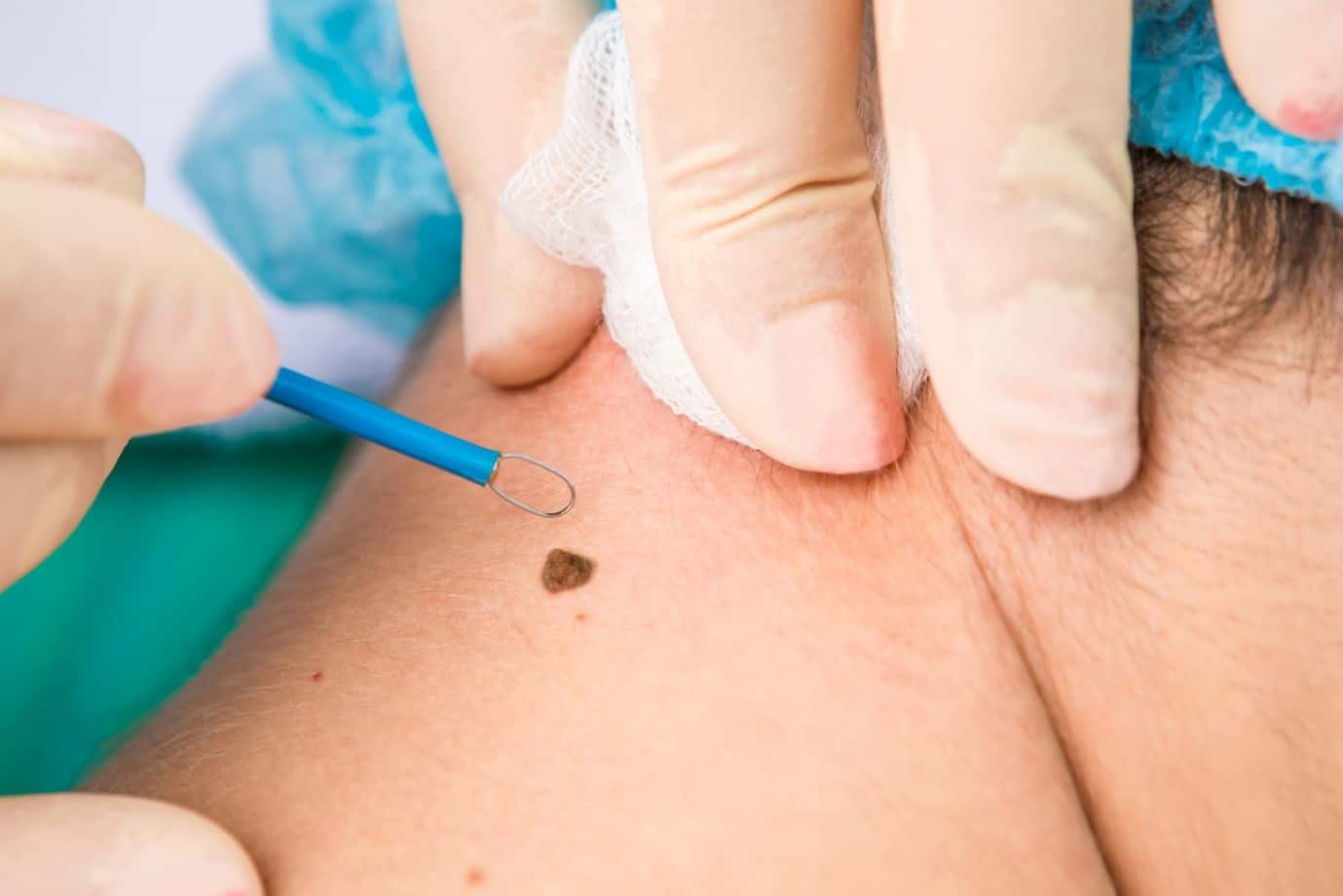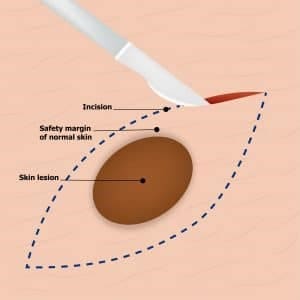Skin moles can be anything from a mild cosmetic annoyance, to a serious worry for your health. Whether you are considering mole removal because its unsightly appearance, or because you are worried about a risk of skin cancer (called a melanoma), you can rest assured knowing it can be easily removed.
In this guide, we will take you through what you need to know about your moles, when to worry about their appearance, and about the mole removal process.
What Are Skin Moles?
Moles are growths on the skin’s surface that are clusters of pigmented cells called melanocytes. Moles are often harmless and they come in all different kinds of shapes and sizes. They commonly appear as round, black or brown in colour, and smaller than the end of the end of a pencil. Moles can appear anywhere on the body and can appear or disappear with age.
Of course, just because a mole is atypical, that does not necessarily mean it is a threat to your health, especially if you have had it since childhood. If you are worried about the appearance of a mole, the best thing to do is to have a doctor examine it for you. We will also touch on some of the warning skins a little later in this guide.
Types Of Skin Mole
There are 2 types of mole: congenital moles, which you have from birth; and acquired moles, which develop during your lifetime. Whichever type of mole you have they are typically circular, can be raised or flat, rough or smooth, and may grow hairs.
Over time moles can disappear, stay the same, or change. Any change in a healthy mole should occur slowly. The darkening of moles is influenced by hormone levels, which is why it is more common in teenagers and pregnant women, genetics, and exposure to the sun.
An atypical mole is generally larger than a common mole, often with irregular borders and different colouring. These skin moles are not always precancerous, but it is important to keep an eye on them. If you prefer, or notice a change, you can have these moles removed in a straightforward procedure and checked for cancerous cells, if necessary.
What Mole Removal Techniques Are There?
There are various mole removal techniques and treatments available in Singapore. What is best for you depends on how many moles as well as the size of it which determines the ideal mole removal technique.
Cosmetic mole removal is a cost-effective solution to eliminate any mole that bothers you because it is uncomfortable, or you simply find it unattractive. For example, you may find having a mole on your face, neck, or chest removed greatly improves your confidence level which can have a serious impact in other important areas of your life.
The types of mole removal you will typically see are:

LASER MOLE REMOVAL
Laser mole removal is best for removal for cosmetic reasons. The moles best for laser mole removal are small, flat, and black or brown in colour. This mole removal technique is generally not appropriate for larger moles, moles that protrude above the surface of the skin, or moles that are deeply rooted.
Laser mole removal is a non-invasive treatment that involves the use of intense bursts of light radiation which works to break down the pigment cells within the mole. Laser mole removal usually requires a number of sessions to completely remove the discolouration caused by the mole. This treatment is particularly useful for areas of the body that are harder to reach or for removing multiple moles at a time. This mole removal technique typically produces the least amount of scarring of all the mole removal treatment methods.
MOLE REMOVAL SURGERY
Mole removal surgery is common for protruding moles, large moles and any which are deemed to be suspicious. There are two mole removal surgery techniques which require local anaesthetic (the area is numbed and the mole is removed). These are:

Shave Excision: This is a technique in which the mole is shaved down using either a scalpel or a sharp razor. This surgery does not require the use of sutures or stitches. Shave Excision mole removal surgery typically leaves minimal scarring and therefore achieves a more satisfactory cosmetic result. The wound is understandably small, and will heal with a temporary, superficial scab that falls off after 1 to 2 weeks to reveal a smooth surface to the skin.

Surgical Excision: This is a technique in which the entire thickness of the mole is cut out of the skin typically with a scalpel, though some surgeons use surgical scissors. This mole removal technique allows your surgeon to remove any part of the mole that penetrates deeper into the skin tissue, and so requires a small number of stitches to close the skin. In most cases, this will leave a small scar that fades over the following year or two, though it can leave a permanent scar that typically looks like a chicken pox scar. Surgical excision results in a decreased likelihood that the mole will reoccur and so this treatment is highly effective for deep rooted moles and those that are considered suspicious.
The best way to decide which mole removal method is right for you is to consult Dr. Vincent Yeow. Click here to find out more.
Why Seek A Plastic Surgeon For Your Mole Removal?
We know that many people often consider removing a mole for cosmetic reasons at home, but this is never a good idea. At home mole removal at best leaves you with additional scarring you would not otherwise have, and at worst may lead to infections and further damage.
While talking to a plastic surgeon about a small cosmetic mole may seem like an overreaction, it is not. A plastic surgeon has been through years of training to ensure they can make cosmetic changes – even on a very minor scale – safely and effectively. They are able to assess of your mole or skin lesion and design a stealth incision specifically for your situation.
This means your scar is minimised and may even be hidden entirely by concealing it along natural skin creases or shadows. Plastic surgeons are able to perform meticulous skin closure techniques that ensure a good postoperative result. Our surgeons use exceptionally fine sutures to keep scarring to a minimum and optimise your body’s ability to heal. Plus, you will have the support of a professional who you can turn to if you have any questions, or if your recovery is not going as planned.
FAQs About Skin Mole Removal
1. How do I know if I need to have my mole or skin lesion removed?
Our surgeons will recommend that you have a mole or skin lesion removed if they have any feeling that it may be cancerous, or if there is a risk that it may become cancerous over time. Some benign (non-cancerous) moles and lesions look very similar to skin cancer, and the only way to tell for sure whether it is cancerous or not is to have it removed and then biopsied (examined in a laboratory).
Moles or skin lesions that are benign, and have no signs of becoming cancerous, can be simply observed and will not need to be removed. However, if a skin lesion or mole is causing you problems, such as it catching on clothing and causing you pain, you may wish to have it removed. You may also decide to have a mole or lesion removed if you are unhappy with how it looks.
2. What are signs of a suspicious or cancerous mole?
Some signs to look out for that indicate a suspicious or cancerous mole include:

A – Asymmetry
B – irregular Borders
C – change in Colour
D – Diameter over 6mm
Depending on the clinical diagnosis of your mole or skin lesion, our plastic surgeons will advise you accordingly on whether you should have it removed.
3. Does mole removal hurt?
No. If you have a Shave Excision procedure or a Surgical Excision procedure the mole and the surrounding area of skin will be numbed using a local anaesthetic, so you will not be able to feel anything during the procedure. If it was a particularly large mole, you may feel some pain after the anaesthetic wears off, but this will be minor.
If you have Laser Mole Removal, you will feel a pricking sensation or like you are being flicked with an elastic band, but this will only last for several minutes per mole.
4. How do I care for my skin after mole removal?
After care for your skin after your mole removal procedure is simple, you just need to be diligent and religiously apply both silicone scar cream and sunblock. This is important to ensure that the scar stays as flat as possible and prevents any pigmentation from occurring due to sun damage while the skin is vulnerable. Some individuals may require steroid injections or laser scar therapy to improve the appearance of their scar and make it less noticeable if that is necessary of a concern.
It is also important to apply sunblock whenever you go outside for several months, as the area of mole removal is more sensitive to the sun. If the scar is small and you intend to spend time out in the sun, some people find using a small plaster beneficial.
5. Mole Removal Downtime: How much rest is required after having mole removal?
Mole removal downtime is relatively minimal. After your local anaesthetic has worn off, you will find that you feel a little pain and discomfort, but this can be reduced with off-the-shelf painkillers. Depending on your job, it is recommended that you take a day or two off work as you may find there to be some swelling and/or bruising where your mole was removed, although this will fade over the course of about a week.
Even with the use of a local anaesthetic you should still be able to take yourself home from your appointment. Your surgeon will let you know during your assessment appointment if they think you need another person to take you home for any reason.
6. How much does mole removal cost?
Mole removal price varies depending on how complex your mole is, how easy it is to remove, and what technique needs to be used in order to remove it. If you require surgical mole removal, this will cost more than laser mole removal. The best thing to do is have an assessment with a surgeon who can detail the costs and you can decide whether to move forward with your mole removal at this time.
7. Can my mole removal be covered by insurance?
Yes, mole removal in Singapore can be covered by your insurance, as long as there is a medical reason for the removal of your mole. The mole removal price with insurance will vary depending on your insurance plan and whether you have already met your deductible. If you have not, it will count as a procedure that goes towards the deductible. However, if you have, your mole removal will be entirely covered by your health insurance plan.
8. How long will it take for my skin to heal after mole removal?
The length of time it will take for your skin to heal after mole removal really depends on you as an individual. Generally, the younger you are the faster you heal, and the smaller the mole the faster it heals. For small moles, you can expect the wound to take around 2 to 3 weeks to heal, but this will vary. You also need to make sure that you practise proper care for the wound initially, as this is essential to prevent chances of infection and will help to minimise scarring.
9. Is it likely that my mole will grow back after removal?
There is always a small chance that your mole will grow back after you have had it removed, due to a tiny number of melanocyte cells remaining in the area of the skin. This is rare, however. If your mole does come back after your first treatment, we will happily schedule a follow up to ensure the mole is completely removed.
Before undergoing any removal treatment, our qualified doctors will thoroughly examine the mole to advise on the most appropriate technique to suit your situation. Do not hesitate to reach out to us if you are looking for mole removal Singapore, to find out more about the mole removal price you can expect, and the mole removal techniques that may be suitable for you.
About Dream Aesthetics and Plastic Surgery
Bespoke surgical for cosmetic or medical reasons is what Dream covers to bring out the beauty in every individual. Going beyond the aesthetics and working on physical anomalies are what we value the most in leading our patients to cherish self-improvement and confident lifestyles.
Derived from Associate Professor Vincent Yeow’s long-standing experience performing plastic surgery in Singapore, our treatment plans deliver physical remodelling in our patients’ favour. One of the notable remodellings is droopy eyelid correction. The ptosis surgery used for treatment eventually fixes drooping eyelids, improves vision and enhances appearance.
Most importantly, as a trustworthy plastic surgery and aesthetic clinic, we treasure positive and natural outcomes for each individual. We will ensure to deliver the beauty refinement of your dream without compromising your safety and privacy.







